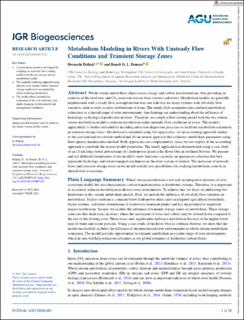| dc.contributor.author | Pathak, Devanshi | |
| dc.contributor.author | Demars, Benoît Olivier Laurent | |
| dc.date.accessioned | 2023-04-14T12:55:39Z | |
| dc.date.available | 2023-04-14T12:55:39Z | |
| dc.date.created | 2023-03-22T14:41:20Z | |
| dc.date.issued | 2023 | |
| dc.identifier.citation | Journal of Geophysical Research (JGR): Biogeosciences. 2023, 128 (3), e2022JG007245. | en_US |
| dc.identifier.issn | 2169-8953 | |
| dc.identifier.uri | https://hdl.handle.net/11250/3063147 | |
| dc.description.abstract | Whole-stream metabolism characterizes energy and carbon transformations, thus providing an estimate of the food base and CO2 emission sources from streams and rivers. Metabolism models are generally implemented with a steady flow assumption that does not hold true for many systems with sub-daily flow variation, such as river sections downstream of dams. The steady flow assumption has confined metabolism estimation to a limited range of river environments, thus limiting our understanding about the influence of hydrology on biological production in rivers. Therefore, we couple a flow routing model with the two-station stream metabolism model to estimate metabolism under unsteady flow conditions in rivers. The model's applicability is further extended by including advection-dispersion processes to facilitate metabolism estimation in transient storage zones. Metabolism is estimated using two approaches: (a) an accounting approach similar to the conventional two-station method and (b) an inverse approach that estimates metabolism parameters using least squares minimization method. Both approaches are complementary since we use outputs of the accounting approach to constrain the inverse model parameters. The model application is demonstrated using a case study of an 11 km long stretch downstream of a hydropower plant in the River Otra in southern Norway. We present and test different formulations of the model to show that users can make an appropriate selection that best represents hydrology and solute transport mechanism in the river system of interest. The inclusion of unsteady flows and transient storage zones in the model unlocks new possibilities for studying metabolism controls in altered river ecosystems. | en_US |
| dc.language.iso | eng | en_US |
| dc.publisher | Wiley | en_US |
| dc.rights | Navngivelse 4.0 Internasjonal | * |
| dc.rights.uri | http://creativecommons.org/licenses/by/4.0/deed.no | * |
| dc.title | Metabolism Modeling in Rivers With Unsteady Flow Conditions and Transient Storage Zones | en_US |
| dc.title.alternative | Metabolism Modeling in Rivers With Unsteady Flow Conditions and Transient Storage Zones | en_US |
| dc.type | Peer reviewed | en_US |
| dc.type | Journal article | en_US |
| dc.description.version | publishedVersion | en_US |
| dc.source.pagenumber | 20 | en_US |
| dc.source.volume | 128 | en_US |
| dc.source.journal | Journal of Geophysical Research (JGR): Biogeosciences | en_US |
| dc.source.issue | 3 | en_US |
| dc.identifier.doi | 10.1029/2022JG007245 | |
| dc.identifier.cristin | 2136191 | |
| dc.relation.project | EC/H2020/765553 | en_US |
| dc.relation.project | Norges forskningsråd: 297202/E10 | en_US |
| dc.source.articlenumber | e2022JG007245 | en_US |
| cristin.ispublished | true | |
| cristin.fulltext | original | |
| cristin.qualitycode | 2 | |

